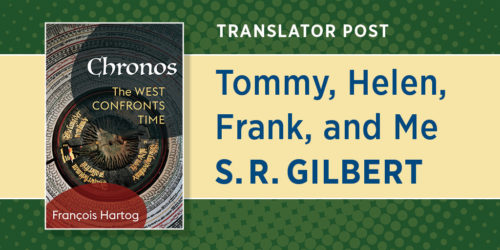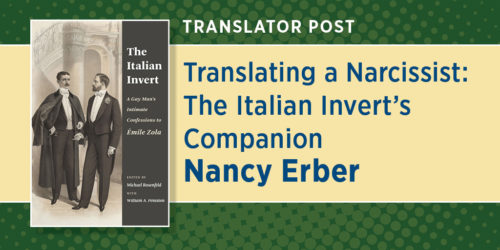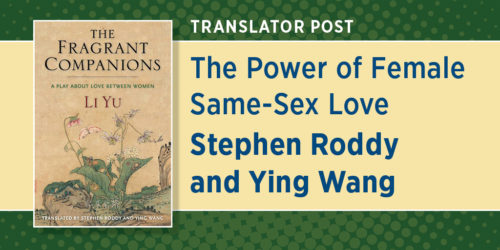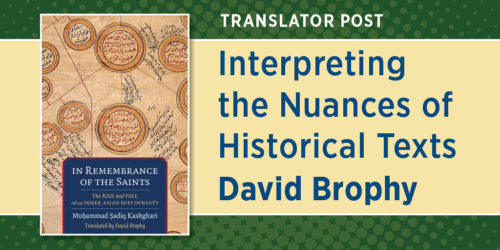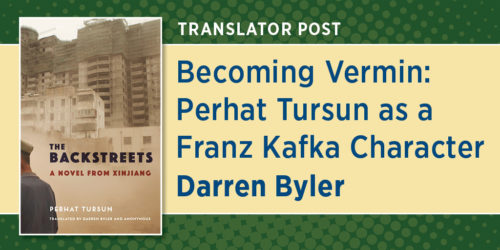The Multifaceted Advice of the Zhuangzi Richard John Lynn
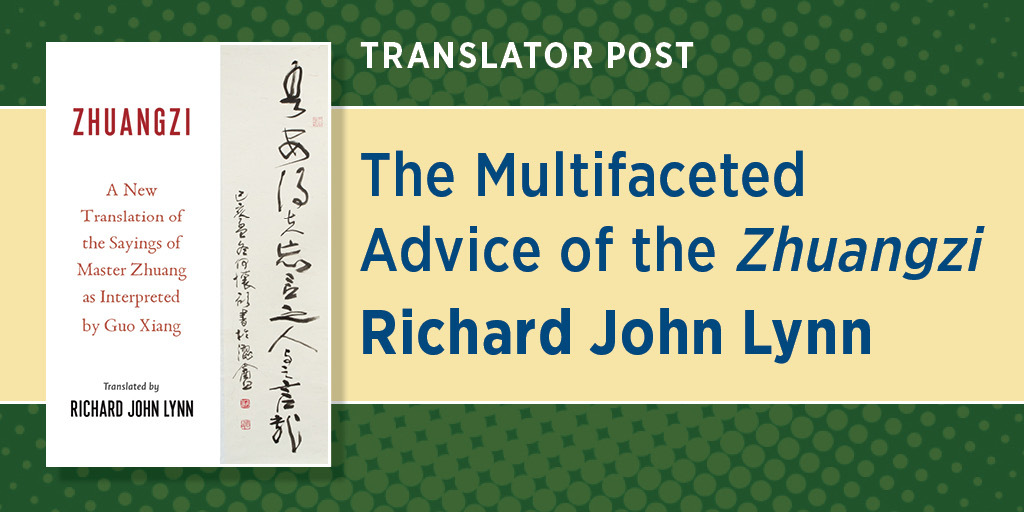
This translation is “new” in that it differs significantly from previous translations since it is based on one particular traditional Chinese commentary, the earliest complete philosophical commentary by Guo Xiang 郭象 (265–312). The translation technique is also “new” in that the text of the Zhuangzi and its commentary are fully integrated—the meaning of the one is determined by that of the other. This integrated approach was also used in my two earlier related works published by Columbia University Press, The Classic of Changes: A New Translation of the I Ching as Interpreted by Wang Bi (1994) and The Classic of the Way and Virtue: A New Translation of the Tao-te Ching of Laozi as Interpreted by Wang Bi (1999). Wang Bi 王弼 (226–249) and Guo Xiang are the two most important figures in the development of xuanxue (arcane learning) thought during the third through sixth centuries CE. In this tradition, these three works are collectively called the sanxuan—the “Three Arcane Classics.” As companion volumes, they link essential features of Daoist metaphysics with Confucian morality and political philosophy to create a coherent worldview of their own, dominant in its own day and immensely influential for the development of terms and concepts in both contemporary Chinese Buddhism of the early medieval era and later Neo-Confucian thought during the Song and post-Song eras (that is, the eleventh through nineteenth centuries CE).
This project, begun at the end of 1999, had a long gestation. Progress was intermittent with long periods of interruption due to various professional and personal obligations. First came my move from the University of Alberta to the University of Toronto, where I served as graduate coordinator for East Asian Studies and professor of Chinese Thought and Literature from 1999 to 2005. My retirement in June 2005 occasioned a move to Gabriola Island, British Columbia. During 2006–2007, I also served as visiting professor in the Department of Asian Studies at the University of British Columbia, in nearby Vancouver. Along the way, several article-length publications, book sections, conference presentations, and public lectures spun off from work on the book, many of which are available for viewing and downloading at Research Gate, including:
- “The Modern Chinese Word for Humour Huaji and Its Antecedents in the Zhuangzi and Other Early Texts”
- “Concepts of Self and Identity in the Zhuangzi”
- “Reception of the Zhuangzi in the West”
- “Truth and Imagination in China: Opposition and Conciliation in the Tradition”
- “Views of War as Seen in the Zhuangzi as Interpreted by Guo Xiang”
- “Guo Xiang’s Theory of Sagely Knowledge as Seen in His ‘Essentials of the Analects’”
- “The Influence of Guo Xiang’s Commentary to the Zhuangzi on Chinese Literary”
- “Thought of the Six Dynasties Era 莊子注對六朝文學思想與文學理論的影響”
- “Birds and Beasts in the Zhuangzi, Fables Interpreted by Guo Xiang and Cheng” Xuanying
- “Wang Bi and Xuanxue”
The wide range of issues covered in these indicate the rich interdisciplinary resources offered by the Zhuangzi and the Guo commentary. Those who wish to read passages of translation along with the original Chinese texts, can refer to “Original Chinese texts of the Zhuangzi and Guo Xiang Commentary.
This project has been immensely rewarding both in its own right—making me a far better reader of such ancient texts than I was when I started—and for making me ever more aware, as progress was made, how interconnected pre-modern Sinological research can be—how, for example, terms, concepts, passages in both the Zhuangzi text and the Guo commentary are used, quoted, and alluded to all throughout the later tradition. I am now well into my next book project—a study of the literary and cultural experiences of Huang Zunxian 黃遵憲 (1848–1905) in Meiji Japan (1877–1882), including an integral annotated translation of Huang’s Riben zashi shi 日本雜事詩 (Poems on Miscellaneous Subjects from Japan)—and sure enough, I have already encountered mentions of Master Zhuang more than a dozen times, either in the poems or in the often lengthy prose topical notes attached to them. And I still have about 30 of the 214 poems to go!
Guo Xiang rendered for the Zhuangzi what Wang Bi provided for the Laozi: he composed a commentary that turned it into a treatise on statecraft, to serve as “advice for the prince.” However, such an interpretation does not preclude the reader from delving into the text for wisdom to enhance personal thought and behavior: it was commonplace throughout the ages to read Confucian and Daoist works of philosophy, including the Zhuangzi, on more than one level. As the traditional Chinese view had it that the state was the family writ large, so the sage ruler of “all under Heaven” was regarded as a model for the aspiring individual sage in his private life. The Zhuangzi can be read this way, as can many other early texts.
The Zhuangzi consists of a large collection of anecdotes, allegories, parables, fables, and relatively brief philosophical expositions, which Guo Xiang’s commentary expands on and elucidates in terms of a coherent system largely of his own making, focused on the key concept ziran 自然 (nature, the natural, natural endowment, natural spontaneity), which Guo argues was lost to mankind due to the corrupting effect of “civilization” but is recoverable through the attainment of sagehood. The Dao is the great prime pattern and all-inclusive matrix of principles of all existence: Heaven and Earth, both animate and inanimate, animal, vegetable, and mineral, and, of course, human beings. The Dao is the sum aggregate of all individual principles, each of which governs natural properties and characteristic behavior. Think of the Dao as the cosmic program that runs the universe. Human beings create (or are) glitches in the program because of their tendency to overreach their natural endowments in the pursuit of power, wealth, reputation, pleasure, and other “unnatural” goals—the bane of mankind. Access to and recovery of the natural self is only possible when one is free of conscious life; when all behavior is free of conscious action (wuwei); and when one responds to things, “the other,” with perfect resonance, that is, arcanely merges or unites and becomes one with them. Whether the Dao exists ontologically both transcendent to things, in dualistic relationship with them, as well as inherent in them, exemplified by the xuanxue (arcane learning) of Wang Bi, or exists only inherently in things, in a materialistic monistic system, epitomized by the thought of Guo Xiang, is a question debated extensively in the arcane learning tradition of the third through ninth centuries CE, a debate that extended into Neo-Confucian philosophy during the later Song and Qing eras.
The Dao is the great prime pattern and all-inclusive matrix of principles of all existence…Think of the Dao as the cosmic program that runs the universe.
The reception of the Zhuangzi in the West has a long history prior to the appearance of the first integral translations in the 1880s and 1890s by Frederic Henry Balfour (1846–1909), Herbert A. Giles (1845–1936) and James Legge (1815–1897). These translations should be studied as part of the seventeenth- and eighteenth-century European encounter with South and East Asian religious traditions—Hinduism, Buddhism, Confucianism, and of course Daoism—a religio-cultural experience that profoundly shaped the development of modern Orientalism before imperialist ambitions and commercial greed during the early nineteenth century compromised what had originally been essentially a search to expand Western religious perspectives by discovering in Asia’s non-Abrahamic religions parallels and precedents for basic Christian beliefs about God, creation, and the individual soul. Key players in this process, especially for the encounter with Chinese traditions, were members of the Jesuit mission to Peking, both before and after 1715 when Pope Clement XI condemned Chinese rites as incompatible with Christian beliefs and the Kangxi emperor retaliated by banning Christian missions in China.
The majority of the Jesuit fathers continued their attempt to effect a Chinese-Christian synthesis based on their accommodation to Chinese culture and their figurist readings of, first, the Confucian classics and then the Yijing 易經 (Classic of Changes); the Laozi (Classic of the Way and Virtue); and, to a lesser extent, the Zhuangzi, the Liezi 列子 (Sayings of Master Lie), and the Huainanzi 淮南子 (Master of Huainan). The writings of Joseph-Henri Prémare and Jean-François Foucquet in particular are important in this regard, as well as the writings of a coterie of eighteenth-century intellectuals who were secular devotees of Christian mysticism—especially the “Quietism” movement, influenced directly or indirectly by the Jesuits, which included Andrew Michael Ramsay and Jeanne Marie Bouvier de la Motte—as well as those who would break with the Christian tradition, like deists Voltaire and Diderot. Father Prémare’s translation of the short story “Zhuang Zhou Drums on a Bowl and Attains the Great Dao” 莊子休鼓盆成大道 by the late Ming writer Feng Menglong’s馮夢龍, is also important, as it introduced the name “Zhuangzi” to the Western world during the eighteenth and early nineteenth centuries. Nonclerical Sinological writings about Chinese thought and religions during the earlier nineteenth century often refer to the Zhuangzi, but little was really added to what the eighteenth century already knew about the man or work until toward the end of the nineteenth century. Balfour’s inept work is now all but forgotten, but Giles’s and Legge’s writings are still in print today and well-known.
Such a translation technique as I have used, based entirely on Guo’s commentary, precludes independent presentation of either the Zhuangzi text or the commentary. That is, translation of the commentary cannot simply be attached to some other translation of the Zhuangzi, such as by Burton Watson or Victor Mair, the two most popular prior English versions, because neither interprets its text consistently in terms of Guo’s commentary, which makes many of their passages incompatible with it. Whereas some of Watson’s and Mair’s passages—mostly those involving straightforward narratives or parables—seem similar not only to each other but to my translations, others with more philosophical content differ considerably because they are either based on different commentaries or are interpretations Watson and Mair arrived at independently.
Richard John Lynn is professor emeritus of Chinese thought and literature at the University of Toronto. He is the translator of Zhuangzi: A New Translation of the Sayings of Master Zhuang as Interpreted by Guo Xiang (Columbia, 2022).


